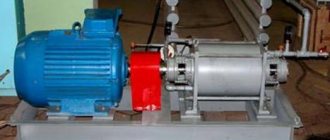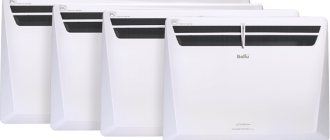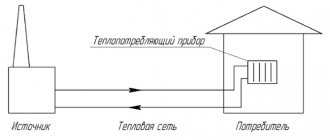SeregaJ7 › Blog › Solar gas. Service.
So two heating seasons have flown by with this heating device.
Like every piece of equipment, it has a number of its own operational features, which you quickly get used to. The main thing: if you want a clean release, use kerosene as fuel. And light the heater outside or under the hood. Select a horizontal platform for installing the heater so that the burner operates equally. Maintenance is the simplest - we get to the wick
Carefully clean the fuel supply pan. The wick consists of 3 layers of fiberglass folded into an overlapping ring
A big role must be played in cleaning the labyrinth burner. In this case, due to good fuel, there was no carbon deposits
Assembly is normal, in reverse order.
Types of autonomous diesel fuel heaters
To begin with, we list all the types of heating devices that use liquid fuel and are most often used by users:
- mini-ovens “Solyarogaz” with a power of 1.8-5 kW from the Russian brand Savo and their analogues;
- various diesel fuel heaters with forced air supply, also known as heat guns;
- a simple direct combustion stove for a garage is one of the most popular home-made designs;
- stove - dropper.
Diesel industrial air heater
Note. The first 2 types of diesel fuel heaters are produced in factories and can be purchased ready-made. The remaining two heaters function equally well on diesel fuel and waste oil, but they must be made independently.
Now we will consider the heating units separately and identify all the positive and negative aspects of their operation.
how does solar gas work?
Hello people, here I was wondering how solar gas works, having scoured the entire Internet, I couldn’t find anything. So I want to ask if anyone here knows how it works and how it doesn’t stop working. It would be nice if anyone can help in detail.
They searched poorly, there is a ton of information on the Internet. Essentially a kerosene stove with catalytic afterburning
No matter what you say, I’ve been trying for days now to find at least something besides the technical properties and where it is implemented there is nothing to be found.
melkie, So, offhand » > » >
I have a similar one. The principle is this. An example: when oil boils, its vapors can easily be set on fire, but when it is in a liquid state, this is not possible. The principle is similar here too. A fiberglass wick is placed in a ring filled with diesel fuel. Soaked in diesel fuel, it can be easily set on fire, but it smokes heavily. A burner is placed on this ring with a wick, which is a cylinder in which there are several rings made of perforated stainless steel sheet, one inside the other. The fire from the wick heats up all these metal parts until red and the wick seems to stop burning, and due to the heat from the insides of the burner, the diesel fuel is converted into steam and burns higher. The ring is filled with diesel fuel according to the principle of a drinking bowl for parrots. Look at the diagrams that Viktorovich gave and delve into it. If the thought crept in to farm this miracle yourself, then it’s not worth it. The price of this stove is not high, but it will be a lot of hassle.
Thanks for the links.
It heats perfectly and there is little smell, but I have created a hood with a corrugated pipe over the burner. This corrugation is taken to the street. I use this miracle to heat my shower. But a problem arose. Somewhere after 1 hour of operation of the device, there is an overflow of kerosene from the receiving bowl, which is not a buzz. It’s great that I noticed it in a timely manner. Can anyone who knows recommend what to do here and how to fight this?
Loversbird wrote: . Somewhere after 1 hour of operation of the device, there is an overflow of kerosene from the receiving bowl, which is not a buzz. It’s great that I noticed it in a timely manner. Can anyone who knows recommend what to do here and how to fight this?
It is necessary to insulate the fuel tank from the heat of the burner. Vaporization of light fractions of kerosene/(temperature expansion of air) leads to “squeezing out” excess fuel into the receiving bowl.
How to make a wick for a solar gas stove with your own hands
Very often, people try to save money on heating rooms where people are not regularly present. In such a situation, using a solar gas stove would be an excellent choice. It does not stop running on diesel and will do an excellent job of supplying heat to small rooms. Plus, the design of the stove is simple and the device rarely fails. Very often you only have to change the wick for solar gas, which is easy to do with your own hands.
Solar gas models are distinguished only by the size and capacity of the fuel tank. In this case, no fundamental design changes are made to the design of the diesel fuel burner. The body of the unit is made of thin sheet iron and painted with glossy paint. This makes it possible to expand the speed of heat energy propagation. A deep cylinder-shaped cutout was created on the front panel of the case to control the stove and improve the convection process.
The fuel tank is welded from two metal boxes and equipped with a control valve. Fuel is poured through such a structural element, and when the tank is installed in the working position, a stable supply of kerosene in the required quantity is achieved. The fuel container is located on the reverse side of the solar gas.
Solar gas. Emergency heating source
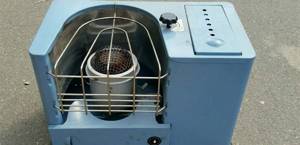
It would be nice, of course, to warm up with helium, but science hasn’t thought of that yet. Therefore, we will continue with solar gas... This unit is one of the top products produced by JSC Savo (Penza). Although similar heaters are also produced abroad (for example, in Korea, Japan), the domestic one certainly wins at its price. More on the rest below.
Principle of operation
Strictly speaking, solar gas is a special class of portable liquid fuel heaters that use the combined convection-reflex principle of local air heating. In addition, on the unit you can heat up some liquid food, cook scrambled eggs, and even brew coffee (if someone likes coffee with a slight kerosene aroma). True, this will happen quite slowly. However, the main thing is not to freeze indoors if:
- It was not originally heated (for example, a garage or basement);
- The electricity at the dacha was suddenly cut off;
- It has an area of no more than 15...20 m² (depending on this parameter, “Savo” produces a whole line of solar gases; we note in parentheses that they could have come up with a better name for the heater... Well, as it is, it is).

Heating using the stove in question occurs in the following sequence:
- Fuel (kerosene, although there is unofficial information that in principle solar gas does not object to diesel fuel) is supplied to a special container, where it wets the wick located in the pan under the burner.
- After some time, the evaporation process begins, in which kerosene vapor enters the upper part of the wick bowl.
- When an air-kerosene mixture is ignited, its temperature increases sharply (up to 600...800 ° C), the mixture flares up, and then begins to burn layer by layer (“layer by layer”, because between the particles of kerosene vapor there is heated air, which, as is known, contains enough nitrogen).
- As the air-kerosene mixture warms up, convection processes are activated, as a result of which open combustion stops, passing into the smoldering phase.
- The waves of thermal radiation released in this case are repeatedly reflected from the surface of the solar gas and accumulated by a reflective grid built into the device. As a result, the temperature in the room gradually increases.
Since the wick is wetted by gravity flow of kerosene, heating will continue until the tank is completely emptied, and the intensity of the fuel supply can be adjusted. Since there are no fuel losses, the efficiency of the heater is quite high: consumption, according to practice, does not exceed 250 ml/h. With a tank capacity of 2 liters, continuous operation of the device will last for 7…8 hours. During this time, either the weather will change or the electricity will finally be turned on. Under no circumstances should solar gas be used as a stationary heat source.
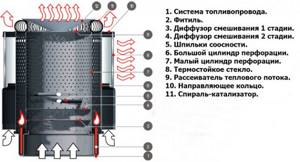
Miracle diesel stove for heating rooms
In many unheated buildings (dacha, garage, greenhouse), the owners are trying to solve the heating problem.
Some people buy electric heaters, a heat gun, and others buy a miniature miracle stove that runs on liquid fuel. The purchase of such a unit allows you to use it without the presence of power in the network.
- Description ↓
- Scope ↓
- Advantages and disadvantages ↓
- Design ↓
- How to kindle ↓
- Security measures ↓
- How to make it yourself ↓
- Necessary materials and tools ↓
- Step by step guide ↓
- Price of a finished stove ↓
- Where to buy ↓
- Reviews ↓
- Rewrite of real reviews from the first person ↓
You can not only heat the room, but also cook food.

Solar gas device
Solar gases differ fundamentally from Savo only in their size and the capacity of the fuel tank. Otherwise, the design of the heater is the same:
- The body is made of thin sheet metal , painted with glossy paint (which further increases the intensity of heat distribution). The body includes three solid walls, while the front panel has a deep cylindrical cutout to facilitate convection and to control the heater.
- Fuel tank , welded from two steel boxes and equipped with a control valve. Kerosene is poured through it, and when the tank is installed in its working position, it ensures a stable supply of a dosed amount of fuel. According to the layout, the tank is located on the back side of the device and is hung on a flat hook.
- Fuel receiver with a mesh filter , which is necessary for frequent use of the heater, as it ensures a stable supply of fuel.
- Bottom wick bowl , which also provides a seat for the burner body. The bowl is equipped with runners, extends back when filling solar gas, after which it slides back into the cylindrical cutout on the front of the body. The wick (or even better, two) is placed in the annular gap of the bowl so as not to block access to the kerosene stream.
How to use?
First of all, solar gas is a technique that, despite its apparent unpretentiousness, requires careful maintenance. For example, solar gas that has not been purified after last year's use most likely will not work.
The heater is prepared for startup as follows. First, fill the tank with fuel using a regular funnel. It is impossible to install the tank on a flat surface - welded ribs get in the way - so you will have to look for a suitable groove. The fuel supply clan is screwed into the tank, turned over and hung on the rear inner wall of the solar gas. The manufacturer's instructions require that some free space be left in the upper part of the tank volume, which will take into account the fact of thermal expansion of kerosene when it is heated. In practice, this warning is ignored, since in fact the volume, if at all, increases, then very little.
Next, the wick bowl is pulled out. The wicks are laid in such a way as to completely cover the perimeter of the annular gap. The entire surface of the bowl should be clean, and not even have individual spots of soot - this can prevent kerosene from accessing the small hole in the bowl through which fuel should flow to the burner (the hole, by the way, is hard to see). After this, the wick bowl moves into its original position.
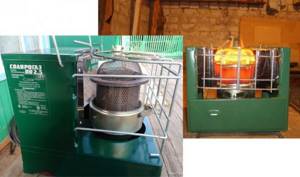
The heater is installed strictly horizontally so that the kerosene can be directed by gravity to the combustion zone. After this, you need to wait a few minutes until the wicks are saturated, and then close the supply and ignite the vapor of the working mixture in the lower part of the burner body with an igniter. Unfortunately, the intensity of the igniter opening must be established experimentally. The manufacturer claims that the ignition time depends only on the characteristics of the fuel, but in practice the initial air temperature in the room, its humidity, etc. also influence. At first, the flame will flare up above the level of the burner grid, but after a few seconds it will become lower, and at this moment fuel must be supplied again. The adjusting screw ensures that the flame does not escape from under the mesh, and that the mesh itself looks like a hot hemisphere. A uniform blue flame should be observed along the entire length of the wick. The process of igniting solar gas, especially for users who do not have experience in operating such equipment, is quite lengthy and can take 30...40 minutes. When ignited, the characteristic smell of kerosene is clearly felt, which then decreases, but still does not completely disappear. This is not a malfunction of the heater, but does not add comfort.
Step by step guide
Using an example, we will look at the design of a gas cylinder, since it will serve as our basis. We do not use forced air supply; it is not required here:
- We free the container from condensate and rinse it thoroughly. Then we bury it in the ground and cut off the top of the container along with the valve.
- Now we have a place for the lid. The legs should be welded to the lower part of the structure. For this we use steel corners.
- Next, cut a hole in the lid for the pipe; the size should be equal to the diameter of the chimney. We weld the pipe into the hole, making sure the seams are tight. We weld the chimney pipe to the horizontal pipe.
- We cut out a square for the blower at the bottom of the structure and install a door to regulate the air.
- Now we prepare the container for fuel. This will be a pipe (70x140 mm) and will be placed at the bottom of the gallon. We weld a piece of the pipe from below, making sure it is tight.
- We prepare a lid with two holes from a sheet of metal. Moreover, we place them in the center and along the edge. We immediately weld a pipe of equal diameter (100 mm) to the central tube. We install a movable flap (diameter 50 mm) to the second hole for filling fuel.
- We install the chimney vertically without any tilting. We choose its length 4 meters, more is possible.
- Pour fuel into the third part of the cylinder. We light a piece of paper and place it on top of the diesel fuel, and the stove lid closes. As the temperature increases, the vapors will ignite.
Reviews and applications
Reviews about the practical use of this heating technology are contradictory. It all comes down to what purposes the solar gas will be used for. The type of heater considered for domestic needs should be considered as a temporary option. At the same time, solar gas is good for heating tourist tents in camping conditions: the unit is compact, does not take up much space, and is equipped with a convenient handle for carrying, although not aesthetically pleasing. In the latter case, in order not to get burned, it is worth considering the issue of removing combustion products (and they are still present) from outside the tent.
Advantages (according to consumer reviews):
- Reliability when switching from one type of fuel (kerosene) to another - diesel. Korean and Japanese technology cannot withstand this.
- The unit is easily disassembled and assembled into its component parts, and this does not impair its performance in any way.
- Using a wick in solar gas is quite economical (one set is enough for 7...10 ignitions, unless, of course, they are long). By the way, instead of a branded wick, you can use any porous fabric (like in a good old kerosene stove).
- The refueling of the heater itself can occur continuously, since even if there is no fuel in the wick bowl, it will power the burner for a few more minutes.
Reviews
Fuel is not expensive for her and does not allow her to go broke. Fully filling the tank allows you to work in the garage for up to 15 hours. I bought a small kettle, eliminating the need to run to the store to drink a cup of coffee. What a MIRACLE oven it is, you can’t call it anything else. I recommend the guys to everyone.
There's probably something wrong with his sense of smell. I don’t like its buzzing noise either; I ask you not to use it at the dacha in front of me. My husband still uses the stove secretly in my absence. I want to say that this is my pure female opinion. But if you think about those hours when there is no electricity, it really helps out.
How to make a wick for a solar gas stove with your own hands
Most often, they try to save money on heating rooms where people are not constantly present.
In such a situation, using a solar gas stove would be a good choice. It runs on diesel fuel and does a good job of heating small spaces. In addition, the design of the stove is simple and the unit rarely fails. Most often, you only have to change the wick for solar gas, which will be easy to do with your own hands. Models of solar gases differ only in dimensions and fuel tank capacity. In this case, no fundamental design changes are made to the design of the diesel fuel burner. The unit body is made of thin sheet iron and painted with glossy paint. This allows you to increase the speed of distribution of thermal energy. A deep cylindrical cutout is made on the front panel of the case to control the stove and improve the convection process.
The fuel tank is welded from two metal boxes and equipped with a control valve. Fuel is poured through this structural element, and when the tank is installed in the operating position, a stable supply of kerosene in the required quantity is achieved. The fuel container is located on the back side of the solar gas.
The fuel receiver with filter is designed to ensure a stable supply of flammable liquid. The bottom wick bowl is equipped with iron runners and can be pulled forward while refueling the stove. The wick is located in a special ring-shaped gap.
The burner body, made in the shape of a truncated cone, has concentric protrusions along the entire generatrix. This allows you to dose the amount of air entering the combustion zone. On the side of the smaller base of the cone there is a mesh through which the heat escapes. The igniter is installed on the side of the housing. The burner itself is a hollow ring with holes on the surface. They are designed to supply a mixture of kerosene vapor and air into the combustion chamber.
The adjusting screw is located on the front panel in its upper part. For efficient operation of a diesel furnace, setting the combustion mode is of utmost importance. If the body is raised too much, the fuel may not ignite, and if it is lowered too low, the mesh will begin to heat up. The last design element is the decorative front panel. It is designed not only to improve the appearance of the unit, but also to prevent accidents when operating the stove .
Heater "Solyarogas": advantages and features

Kerosene, summer and winter diesel fuel (diesel fuel) or gas are used as energy carriers. Solar gases are easy to use and do not require installation of a chimney. The complex of excellent characteristics gave the devices a second name - a miracle oven.
Areas of application
Solar gases are most often used for heating rooms. It could be:
- warehouse with cross-ventilation;
- garage;
- workshop;
- basement;
- vegetable store;
- construction site, etc.
Equipment of this type is usually used in emergency situations: the lights are turned off at the dacha or in the workshop, and the electric heaters stop working. Solar gases help create comfortable conditions for temporary stay in unheated rooms with an area of 15-20 square meters. m.
The devices can also be used to reheat or cook food, but the food will take a long time to cook.
Advantages of heaters
- Wide range of models
. The manufacturer offers several models with power from 1.8 to 2.9 kW.
- Economical
. The device operates on several types of fuel and does not require complex modifications or replacement of burners. One refill is enough for 8-10 hours of continuous burning.
- Compactness
. The equipment fits in the trunk of a car. For ease of carrying, the body has a folding handle.
- Convenient form
. A small pot or pan stands stable on the grate while cooking. When using the Solarogas heater, displacement and overturning of the device are excluded.
- Original fuel system design
. The device can be refueled directly during the combustion process. If this option does not suit you, you can remove the tank and add fuel. There is always a small volume of kerosene or diesel fuel in the storage bowl, sufficient to operate the heater for several minutes.
- Strength
. Sheet metal is used to make furnaces. The products are durable and reliable. The internal design is as simple as possible; there is nothing to break in it.
The disadvantage of solar gases is the release of fuel combustion products. The equipment may only be used indoors for a short period of time. To supply oxygen during the heating period, it is recommended to open the window or provide ventilation to the room in another way.
Operating principle of solar gases
Fuel is poured into a special container. The liquid impregnates the wick located under the burner in a metal tray. As fuel evaporates, gaseous fuel accumulates in the upper part of the wick bowl.
When the air-kerosene mixture is set on fire, a flash occurs first, and then an even layer-by-layer combustion begins, turning into smoldering. Thermal energy is repeatedly reflected by the internal surfaces of the device and accumulates in a reflective grid, from where it is released into the room.
The rate of fuel evaporation, and hence the heating temperature, can be adjusted. Losses of kerosene to the external environment are excluded, since the liquid is in a closed housing.
Design features of Solarogaz heaters
The design of all models in the series is the same. They differ from each other only in the volume of the fuel tank.
- Sheet steel housing . The metal is powder coated with a glossy sheen. The coating protects the housing from corrosion. The three walls of the Solar Gas are made solid, and the front panel has a recess for better convection and convenient adjustment.
- Fuel tank . The container consists of two metal boxes. To fill the tank with fuel, a control valve is provided, which simultaneously serves as a dispenser. The container is attached to a special hook on the back of the case.
- Fuel receiver . The element is equipped with a fuel filter, which reduces the formation of soot, smoke, carbon deposits and increases the service life of the device with frequent use.
- Wick bowl . The part is fixed on runners. When filling the tank, it is moved back and then returned to its original position. The wick is placed in the annular gap of the bottom bowl.
- Burner body . The product is in the form of a truncated cone and is designed to create optimal air flow. A flat or hemispherical mesh is installed on the base of a smaller radius - heat escapes through it. An igniter is attached to the side of the body.
- Burner . The element has the shape of a thick hollow ring. Holes are drilled along the diameter of the product. They are designed to supply the fuel-air mixture into the combustion chamber.
- Adjustment screw . A convenient device that regulates the distance between the burner and the bowl. Using a screw, fuel consumption is set.
- Front Panel . The surface has a protective and decorative function. The front panel protects the user from possible burns, closes the igniter and additionally releases thermal energy into the surrounding air.


